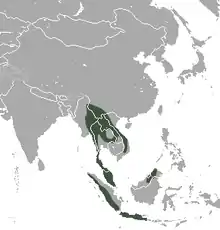Short-tailed gymnure
The short-tailed gymnure (Hylomys suillus) is a small mammal from the family of the Erinaceidae. The scientific name of the species is first published by Salomon Müller in 1840.
| Short-tailed gymnure | |
|---|---|
 | |
| Hylomys suillus | |
| Scientific classification | |
| Domain: | Eukaryota |
| Kingdom: | Animalia |
| Phylum: | Chordata |
| Class: | Mammalia |
| Order: | Eulipotyphla |
| Family: | Erinaceidae |
| Genus: | Hylomys |
| Species: | H. suillus[2] |
| Binomial name | |
| Hylomys suillus[2] S. Müller, 1840 | |
 | |
| Short-tailed gymnure range | |
Description
The upperparts of the short-tailed gymnure are reddish brown to dark brown, with a grey tinge. The underparts are light grey, with white-tipped hairs. It resembles a large shrew, with a long snout and a very short hairless tail. It also has rounded, leathery ears.[3] The head and body length is 12–14 cm (4.7–5.5 in) and the tail length measures 2–3 cm (0.79–1.18 in)[4]
Habits and habitat
The short-tailed gymnure is active both during day and at night. It lives in hilly and montane forests up to 3,000 m (9,800 ft), and sometimes in humid lowland forests. It feeds mainly on insects on the ground but also sometimes takes fruit. It normally does not live any longer than 2 years.[4]
Distribution
The species lives mainly in Southeast Asia (Brunei, Cambodia, Indonesia, Laos, Malaysia, Myanmar, Thailand and Vietnam), but it is also found in China.[4]
References
- Chiozza, F. (2016). "Hylomys suillus". IUCN Red List of Threatened Species. 2016: e.T40611A115175083.
- Hutterer, R. (2005). Wilson, D.E.; Reeder, D.M. (eds.). Mammal Species of the World: A Taxonomic and Geographic Reference (3rd ed.). Johns Hopkins University Press. p. 218. ISBN 978-0-8018-8221-0. OCLC 62265494.
- Feldhamer, George; et al. (2015). Mammalogy: Adaptation, Diversity, Ecology (fourth ed.). Baltimore: Johns Hopkins University Press. p. 285. ISBN 978-1-4214-1588-8.
- Shepherd, Chris R.; Shepherd, Loretta Ann (2012). A Naturalist's Guide to the Mammals of Southeast Asia. Wiltshire: John BeauFoy Publishing. p. 14. ISBN 978-1-906780-71-5.
